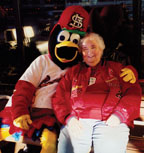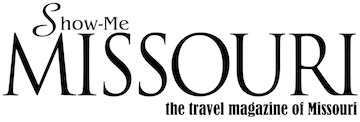
For more than 10 years, Kristen Lokemen was a staff writer and travel specialist for Show-Me Missouri. Over the summer of 2001 she assisted in conducting a tour of the Lewis and Clark Trail from Missouri to the Oregon coast and subsequently penned an 11-part series that ran through the bicentennial observance of the expedition's kickoff. She would eventually lead numerous other tours along that same path, sharing her enthusiasm with hundreds of travelers.
Sadly, Kris died on May 26, 2018. Of all the stories that Kris wrote for Show-Me Missouri, none stand out more than her series on Lewis and Clark's Corps of Discovery. Over the next two weeks, we will run the series in its entirety.
Corps of Discovery: Under A Gentle Breeze
The summer of 1804 was a somewhat idyllic time for Lewis and Clark and the Corps of Discovery. On many mornings they set out “under a gentle breeze,” as Clark and others would write in their journals. Almost everything about the experience was new to them—the country through which they were traveling, the animals and plants that Lewis was discovering and analyzing, even some of the food that they were eating. Beaver tail and buffalo hump, which became favorites of the men, were not served in their homes back east.
During those first two and a half months the expedition had also avoided encounters with Indian tribes, who were out on their summer buffalo hunts. While establishing relations with the Native Americans was one of their more important directives from President Jefferson, Lewis and Clark were very aware of the potential for danger in such meetings. They would travel almost 650 miles before meeting up with their first tribe.
The city of Council Bluffs, Iowa is named for the nearby site of Lewis and Clark’s meeting with the Otos on August 3, 1804. The Otos were a small tribe that lived in what is now Nebraska. They had been joined by the remaining Missouri Indians in the late 1700s. While the Otos were peaceful, primarily farmers and hunters, just knowing that they were in the vicinity made the night before the council an anxious one for the men.
However, there was little need for worry. This first experience with the Indians would be mostly positive. The Captains dressed for the occasion in their full military regalia. Lewis prepared a lengthy speech, telling the Otos that the Missouri River country was no longer in the hands of the French or Spanish. It now belonged to the United States and they had a new white father.
In “Undaunted Courage,” Stephen Ambrose characterizes Lewis and Clark as advance men in these situations. They were there to sell the Indians on the possibilities open to them. If they acquiesced to their new father’s wishes, trade would open along the Missouri and they would benefit. If they defied “The Great Father,” there were other tribes with whom he could negotiate.
The Otos saw the amount of goods that the expedition carried and were disappointed when the gifts they were given were small and of no real value. Instead of the desired guns, powder or whiskey, they were given small amounts of paint, a comb or a peace medal that featured a likeness of Jefferson, their new white father, on one side. The Pacific Ocean was still very far away and the captains knew that it would take everything they had with them to make the journey successfully. They simply couldn’t afford to be too generous.
After the council, the two groups went their separate ways. They would meet again upriver near present day Sioux City on August 18. George Drouillard and three other men had been sent out to find Private Moses Reed, who had returned downriver to retrieve his knife. When he didn’t return after three days absence, the captains feared that he had deserted. It took ten days, but Drouillard got his man. He also brought in Little Thief, the head chief of the Otos, who had been out hunting at the time of the first council.
Private Reed was court-martialed for desertion, which could have been a capital offense. Instead, he was discharged from the permanent party and would be sent back to St. Louis with the keelboat in the spring. For the rest of Reed’s punishment, Clark wrote that “we only Sentenced him to run the Ganelet (gauntlet) four times through the Party and that each man with 9 Swichies Should punish him.” That amounted to about 500 lashes.
The Oto chiefs were appalled at the sentence and asked that Reed be pardoned. However, after the captains explained the severity of the offense and that the sentence was “the Customs of our Countrey,” the Indians were satisfied and witnessed the punishment.
That night all of the men celebrated Meriwether Lewis’ 30th birthday with an extra ration of whiskey and the sound of Pierre Cruzatte’s fiddle. In the morning it was back to business with the Otos. Big Horse, one of the chiefs, came to breakfast naked as a way to show how poor they were. He told the white men, “I came here naked and must return home naked. If I have something to give the young men I can prevent their going to war.”
Again the Indians were disappointed in not receiving valuable goods, but their small numbers did not make them worth the investment. However, Lewis was pleased when Little Thief agreed to travel to Washington, D.C. the next spring to meet with Jefferson.
As the expedition continued upstream that day, a new concern had arisen. Sergeant Charles Floyd, one of the most respected members of the group, had become seriously ill with “Biliose Chorlick” as Clark described it. The Captain also wrote, “we attempt in vain to relieve him, I am much concerned for his situation.”
On Monday, August 20, the boats put to shore in a vain attempt to help revive Floyd. Sergeant John Ordway wrote in his journal: “Sergt. Charles Floyd Expired directly after we halted a little past the middle of the day. He was laid out in the Best Manner possable. We proceeded on to the first hills. There we dug the Grave on a handsome slightly Round knob close to the Bank. We buried him with the honours of war.” The bluff was named Floyd’s Bluff and a nearby river also named for him. The tallest monument to any member of the Corps of Discovery marks his grave today on the bluff above the Missouri.
Patrick Gass was elected sergeant to replace Floyd and on August 26 Lewis made Gass’ new rank official. He wrote orders making Gass “sergeant in the corps of volunteers for North Western Discovery.” From this phrase would come the shorter name that the expedition is known by today.
As August drew to a close, the men entered Sioux country. On August 29 at Calumet Bluffs a council was held with chiefs of the Yankton Sioux. The meeting went much as the one with the Otos had. Old Dorion, the French-Canadian they had met in central Missouri and persuaded to return upriver with them, did the translating. Lewis gave his speech and truly had no comprehension how insulting and condescending it was to the Indians with whom he was trying to build trust.
But Lewis was lucky. The Yankton Sioux were generally peaceful and the young men of the Corps and the young Indians accompanying the chiefs enjoyed showing off their skills and getting to know one another. Clark was impressed with the quality of this tribe of Indians, calling them “a Stout bold looking people & well made.”
Like the Otos, the Yanktons were disappointed in the gifts they were given, but the Yankton chief agreed to go to Washington in the spring. The captains agreed to let Dorion spend the winter with the tribe to help make the arrangements for the trip east. They sent Dorion and the chiefs off across the river with a bottle of whiskey and carrots of tobacco. Lewis and Clark and their men headed the keelboat and pirogues upriver, with the words of one of the chiefs resounding loudly within them: “I fear those nations above will not open their ears, and you cannot I fear open them.” Those nations above included the Teton Sioux.
The Corps of Discovery next encounters its first real threat, the Teton Sioux.
P.O. Box 53
Kennett, Missouri 63857
Toll-Free: (888) 751-6334
Local: 573-888-1100
Email: info@showmemissouri.net
